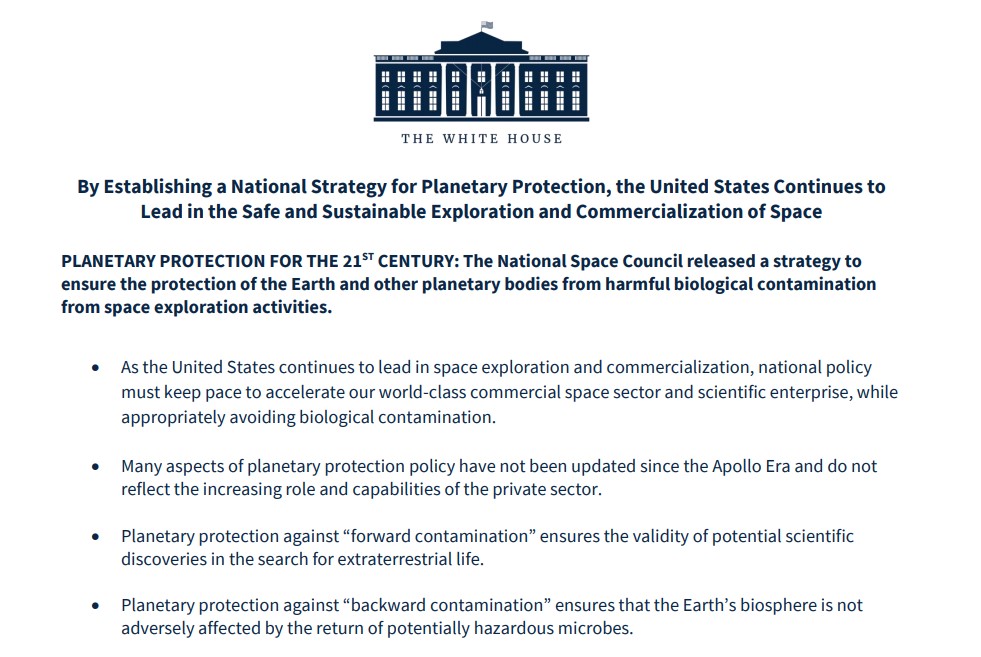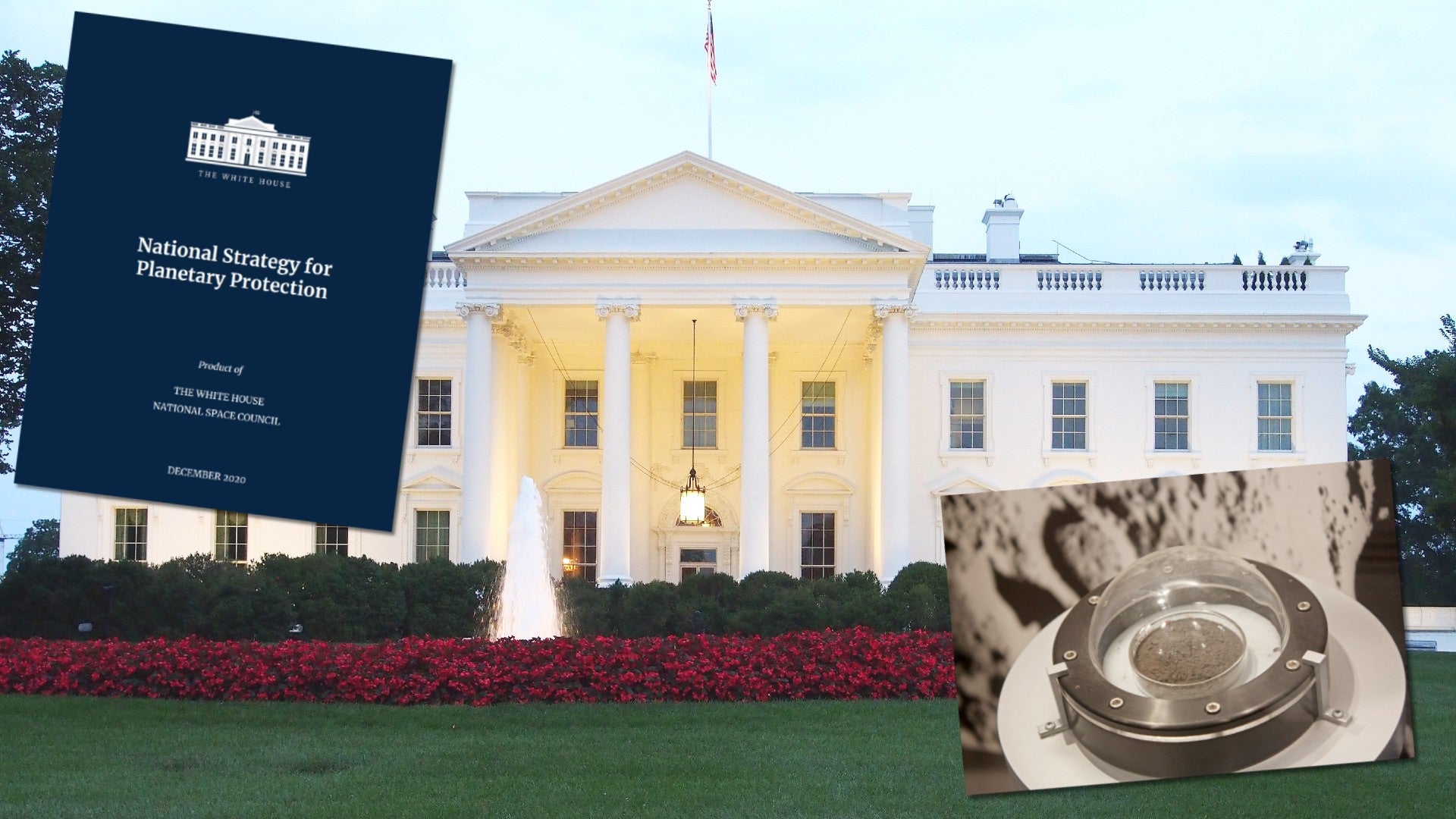The National Space Council and Office of Science and Technology Policy, or OSTP has released a new version of its “National Strategy For Planetary Protection.” The document is about alien invasions, but not the kind we are most accustomed to from science fiction. It outlines various strategies and policy goals that various stakeholder agencies, including NASA, the Department of Defense, and the Federal Emergency Management Agency, can employ to ensure “the sustainable exploration of space by appropriately protecting other planetary bodies and the Earth from potentially harmful biological contamination from space exploration activities.” A full version of the planetary protection plan, as well as a truncated fact sheet, can be found on the official White House website.
The National Strategy For Planetary Protection comes on the heels of several other significant space policies released by President Donald Trump’s Administration, the most significant of which being the creation of the United States Space Force. The world’s superpowers have been jockeying for position in the new space race over the last two decades, and questions and concerns over the militarization of space loom large.

Aside from increasing military presence in space, concerns are also being raised over the commercialization of space as private companies continue to put more and more technologies into orbit and will eventually be sending their own systems to other celestial bodies, like the moon, asteroids, or even the Red Planet. A number of countries are also accelerating their physical exploration of space, both manned and unmanned, including a race to put humans back on the Moon and eventually Mars.
With the prospect of a future in which many spacecraft will be launching to and returning from extraterrestrial bodies, the risk of either forward contamination—bringing Earth-based microbes to other worlds—or backward contamination—bringing home possible extraterrestrial biological material—is a chief concern among planetary scientists and homeland security policymakers alike. With that in mind, the White House’s National Space Council drafted and published the National Strategy For Planetary Protection to define the need for dealing with these issues and to outline strategies by which contamination of either kind can be minimized or mitigated.
The document does not lay out any specific policies, but continues the work done by NASA and other governmental organizations to “develop a more cohesive national effort that balances scientific discovery, human exploration, and commercial activity in space.” The report gathered input from a wide variety of agencies that make up the Interagency Working Group on Planetary Protection. In 2019, planetary scientist and former NASA associate administrator Alan Stern told reporters that planetary protection has been a NASA priority for decades. “At the time planetary protection was born at the beginning of the Space Age in the 1960s, we knew very little about the planets and their environments and their habitability; their suitability for astrobiology,” Stern said during a call with reporters. Now, Stern said, “we have a much more nuanced and, for that matter, sophisticated view of them.”
The issue of planetary protection dates back to the late 1950s with the formation of the U.S. National Academy of Sciences’ Committee on Contamination by Extraterrestrial Exploration (CETEX), an ad hoc group that made the first recommendations about sterilization of spacecraft in order to prevent possible contamination of other bodies. In 1967, the United Nations passed the Outer Space Treaty, formally known as the Treaty on Principles Governing the Activities of States in the Exploration and Use of Outer Space, including the Moon and Other Celestial Bodies. Article IX of that treaty states, in part, that all nations adhering to the treaty “shall pursue studies of outer space, including the moon and other celestial bodies, and conduct exploration of them so as to avoid their harmful contamination and also adverse changes in the environment of the Earth resulting from the introduction of extraterrestrial matter and, where necessary, shall adopt appropriate measures for this purpose.” Over 100 nations are now party to the treaty.
Just a few years after that treaty was ratified in the United Nations, the Apollo 11 astronauts splashed down on in the Pacific on July 24, 1969. Following their recovery, the three astronauts were quarantined for three weeks in order to prevent any potential contamination.

Members of the Interagency Working Group on Planetary Protection that drafted the new National Strategy for Planetary Protection include the Centers for Disease Control and Prevention (CDC), Environmental Protection Agency (EPA), Federal Aviation Administration (FAA), Federal Bureau of Investigation (FBI), National Security Council (NSC), and eight of the cabinet-level departments of the executive branch including the Departments of Defense, Homeland Security, Agriculture, Commerce, Health and Human Services, Justice, State, and Transportation. The working group was formed in July 2020, and the report was released on December 30.

The document outlines three key objectives for the National Strategy for Planetary Protection:
Objective 1: Avoid harmful forward contamination by developing and implementing risk assessment
Objective 2: Avoid backward contamination by developing a Restricted Return Program to protect against adverse effects on the Earth environment due to the potential return of extraterrestrial life
Objective 3: Incorporate the perspective and needs of the private sector by soliciting feedback and developing guidelines regarding private sector activities with potential planetary protection implications
The third objective is becoming increasingly significant as NASA has turned to the private sector for help in launching spacecraft and even retrieving samples from extraterrestrial bodies, such as the moon. Outside the United States, the Japan Aerospace Exploration Agency (JAXA) recently retrieved samples from the asteroid Ryugu, while China’s Chang’e 5 mission retrieved 4.4 pounds (2 kilograms) of lunar regolith in late 2019. Meanwhile, NASA’s OSIRIS-REx spacecraft is set to deliver samples of the asteroid Bennu back to Earth on Sep. 24, 2023. NASA is already planning to send astronauts back to the moon with its Artemis III mission in 2024, a mission that could see the first woman on the moon.
These objectives are described further in the section of the document headed “The Purpose of Planetary Protection:”
The practice of planetary protection is grounded in the premise that life may exist beyond the Earth’s biosphere. Should life exist elsewhere in the universe, measures to avoid the introduction of external contaminants are necessary in order to protect life on Earth and ensure the validity of any scientific study related to such a discovery. In essence, planetary protection refers to the policies and practices related to two aspects of space exploration. First, planetary protection aims to protect future scientific investigations by limiting the forward biological contamination of other celestial bodies by terrestrial lifeforms. Second, planetary protection aims to protect Earth’s biosphere by preventing the backward biological contamination of Earth by returning spacecraft and their payloads.
For missions that may land on the surface of, or be in proximity to, another planetary body that may harbor life, planetary protection practices are implemented to avoid the harmful biological contamination of that planetary body. For example, if traces of bacteria are discovered on a mission to Mars, researchers would need to determine that the organism was not accidentally brought from Earth. Likewise, if the mission profile includes a return journey to Earth, the prevention of harmful biological contamination of Earth becomes a key consideration. Accordingly, the sampling and return to Earth of material from other planetary bodies must utilize appropriate methods of containment so as to avoid unintended interaction with Earth’s existing biology, such as the accidental introduction of an extraterrestrial pathogen.
Dr. Scott Pace, Deputy Assistant to the President and Executive Secretary of the National Space Council, issued a statement accompanying the document’s release. “Current and future missions to Mars and other destinations necessitate a strategy to support a safe, sustainable, and predictable Earth and space environment,” Pace said. “By establishing objectives for the implementation of the 2020 National Space Policy’s direction on planetary protection, this strategy continues American leadership in scientific discovery, human exploration, and private sector space activities.”
Immediately after the document’s publication, Pace stepped down from the National Space Council in order to return to George Washington University, where he previously served as Director of the Space Policy Institute within the University’s Elliott School of International Affairs. In a statement, Pace said the past four years were “among the most ambitious and productive years for the United States space enterprise” and the work the council has done under his leadership has “set a foundation for continued progress and advancement in the civil, commercial, and national space security sectors.” It remains unclear if the incoming Biden administration plans to continue the National Space Council, which was created by law under the 1989 NASA Authorization Act. President Donald Trump is the first president to fund and staff the Council since President George H.W. Bush.

The new National Strategy For Planetary Protection comes on the heels of several other policy documents released by the White House since 2017, including six new Space Policy Directives and a new National Space Policy released in 2020. One of these, Space Policy Directive 4, released February 19, 2019, covered the aforementioned establishment of the United States Space Force.
As America’s military and civilian policies increasingly turn towards space, we can expect to see many more policy directives coming from the executive branch. An extension of this reach into space means governmental agencies and other stakeholders must be prepared for any eventual discovery of extraterrestrial life, which will likely be microbial. In this time of a global pandemic, it goes without saying that even tiny terrestrial microbes can cause widespread societal disruption and threaten national security, let alone alien ones.
Those matters aside, it’s exciting to see the White House discussing planetary protection and potential contamination by extraterrestrial microbial life. Mitigating potential contamination is far from just an American issue, as other nations continue to catch up with the United States in terms of space exploration. Hopefully, international cooperation along the lines of the Outer Space Treaty can continue to push the issue forward in meaningful ways, keeping potential space invaders of any size from contaminating Earth and possibly harming our ecosystems.
Contact the author: Brett@thedrive.com
